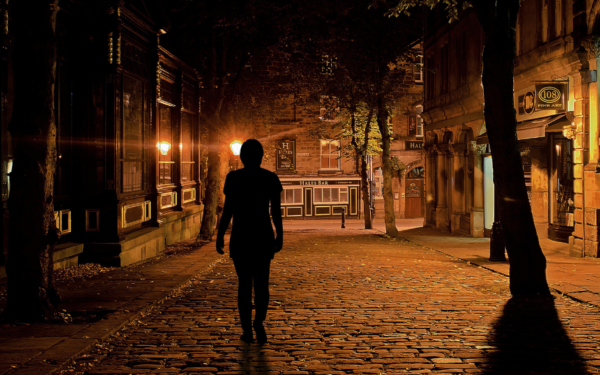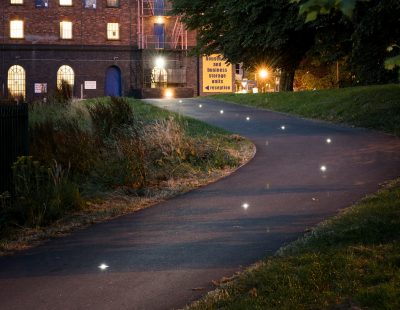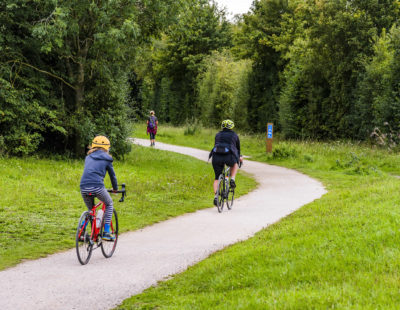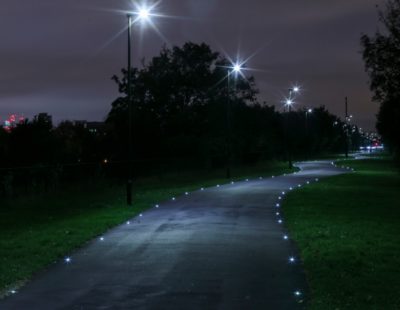Walking and cycling are the greenest modes of transport, offering scores of benefits to individuals and the local environment too. From boosting health and fitness to improving air quality and road safety, there are many reasons to promote active travel.
In 2020, cycling increased by 200% as more and more people shunned public transport and strove to boost their activity levels during the COVID-19 lockdown (source). However, according to government statistics, the proportion of adults who cycle once per week for any purpose is still only 11.6%. Clearly more needs to be done to facilitate access and safety for pedestrians and cyclists in order to maintain and increase these rates.
Solareye have over 30 years’ experience making roads, cycleways, walkways, and public amenities safer for people to use. We’re driven by solutions, and use our knowledge and ingenuity to create sustainable, high quality solar lights that facilitate safer cycling and walking in the dark.
In this blog, we outline some strategies local authorities could adopt to promote cycling and walking in their area.
How to encourage cycling
Cycle tracks
The first step when it comes to creating cycling friendly areas is to provide logical, accessible, and good quality cycle routes. Consider creating new cycle tracks between major destinations, residential areas, and places of work. Off-road options offer numerous benefits for road safety. Where this is not possible, create cycle lanes on existing roads, ideally raised or segregated from the main traffic. An alternative to this is the painted cycle lane, but it’s important to ensure the space provided is sufficiently wide.
Looking to the future, introduce a new rule that all new roads are built with an incorporated cycleway. It’s much more difficult to retrospectively add cycle lanes to roads. This way, all infrastructure in the years that follow will be built with cycling in mind.
Benefits of Cycle Tracks in Towns and Cities >
Lighting
It’s no good having a network of cycle tracks if they’re not delineated effectively. Providing adequate lighting is vital to encourage long term use. In the winter months, shorter days and lack of lighting provision are likely to significantly reduce the amount of people opting for active modes of travel.
And it’s easy to see why. If cyclists and walkers don’t feel safe, they will choose to drive. But, if local authorities light their tracks to provide better comfort, safety, and visibility for all, they can start reaping the benefits of active travel all year round.
Solareye’s high quality LED solar ground lighting boasts impressive visibility, minimal maintenance, skid resistance, and can even be adapted to mitigate environmental impact. Our Bat Hat, for example, limits upward light spillage by 98%!
Read next: LED Solar Lights for Cycle and Bike Paths
Prioritise cyclists
Making cities and towns safer for cyclists involves prioritising their needs over that of motorists. Areas where there is a high risk of collisions, for example, should implement speed limits of 20mph. Traffic light signalling can also be put in place to favour cyclists.
Other measures might include creating ‘bike boulevards’ where barriers are installed allowing bikes to pass through, but not cars. Not only will this make journeys by bike much safer, but it will also result in quieter, less congested town and city centres. To take this idea one step further, you could consider following Bogotá’s example and introduce Ciclovía days. On Sundays and public holidays, Bogotá has a car free policy in select main streets.
Bike infrastructure
Cycling for leisure is one thing, but if you want to promote cycling as an alternative means of transport, you will need to provide infrastructure to allow bikes to be locked away safely when not in use. Invest in bike storage facilities in town and city centres and other places that might offer a logical destination for commuters. Here, too, good quality lighting will do wonders to improve comfort and confidence among users – why not use our LED solar roof light, perfect for covered bike storage!
You could also consider offering bike hire in your local area, something which has been done to great success in many major cities. Install docking stations at intervals throughout the streets and at main attractions to encourage visitors and those without a bike to give cycling a go!
Cycle to work
A great way to promote cycling on a large scale is to encourage employers to sign up to cycle to work incentive schemes. These schemes allow employees to receive bikes and other equipment at a greatly reduced cost which they pay in small instalments through their salary.
Employers could also install showering facilities at the workplace and provide secure bike storage. Work with local businesses to educate them on the benefits of cycling when it comes to productivity and employee health, and you can boost active commuting on a large scale.
How to make streets more pedestrian friendly
Lighting
Walking around in the evenings, particularly when alone, makes many people feel unsafe. To promote an increased sense of safety through strength in numbers and civil security, particularly in the winter months, adequate lighting is imperative. Ensure lights are placed at regular intervals along streets and footpaths to provide optimum safety for users. When it comes to spacing our LED solar lights, we’ve created a spacing guide to help you get it right!
Our solar ground lights are a great way to delineate pathways with maximum user comfort but minimum maintenance. Explore the full range here.
See more: Understanding the Best Options for Public Outdoor Lighting
Signage
Road users can rely on frequent signage to help them find their way, even if they’re driving somewhere new. But what about walkers? Here, signage is often less consistent. By creating and installing regular signs to help walks navigate the local area, you’ll make journeys by foot much easier. You could even consider advising walkers on distance or journey time, helping them plan their route.
Improve walkability
Walkability refers to how friendly an area is to walking and can be improved in various ways. A key thing to consider might be how attractive your walkways are, and whether they could be improved by creating more parks and green spaces.
Another factor to think about is how logical the routes are. Make sure you provide crossing points at key desire paths to ensure walkers can quickly and easily cross the road where they need to. Otherwise, you run the risk of people attempting to make unsafe crossings.
Related: The Ultimate Guide to Pathway Lighting
Communicate benefits
As with cycling, communicating the benefits of walking for health, the environment, and the local area makes a big difference to uptake. Education in schools, workplaces, and other organisations can prompt more and more people to start making walking part of their daily life.
Benefits of creating pedestrian and cyclist friendly cities
Increasing the amount of people cycling and walking in your local area has positive impact on the individuals themselves and the local area. Check out the following benefits:
- – Less congestion
- – Healthier population
- – Reduced noise
- – Improved air quality
- – Better social cohesion
- – Lower rate of road traffic accidents
Encouraging active travel is one of the easiest ways local authorities can create more sustainable cities and towns. Start implementing some of these ideas today and you’ll be doing your bit to help create a greener world for all – and a healthier one!
Ecological Considerations for Pathway Lighting >
High quality solar lighting for your cycle track & pathway
If you have a cycle track or walkway you need to delineate at night, our solar lights are a quick and cost effective solution. They’re perfect for areas that are difficult to maintain and don’t require any hard wiring. With minimal disruption and maximum effectiveness, our lights make it easy to create safe, comfortable outdoor spaces.
Contact us for more information or explore our full range!
Read more: The Ultimate Guide to Ground Lighting
Read more: What is Eco-Friendly Lighting? Everything You Need to Know





